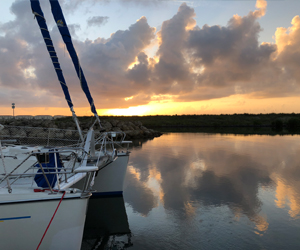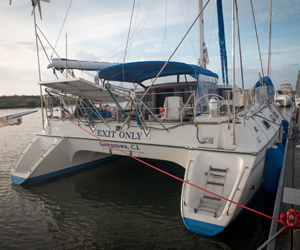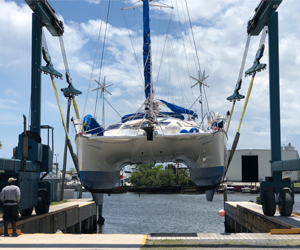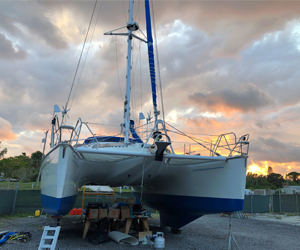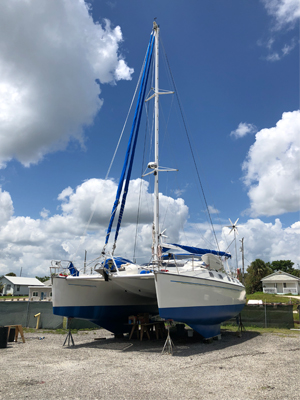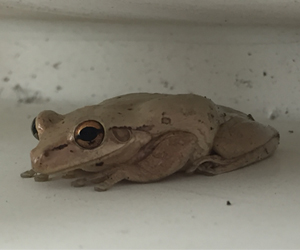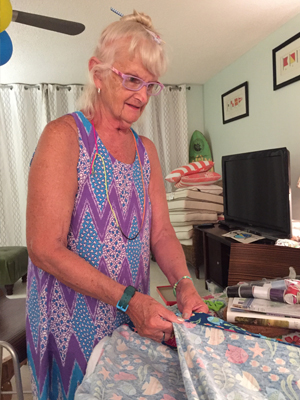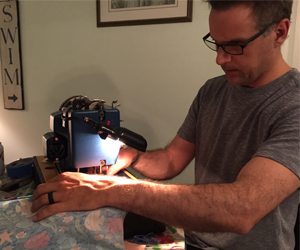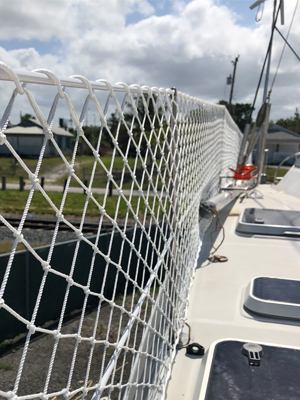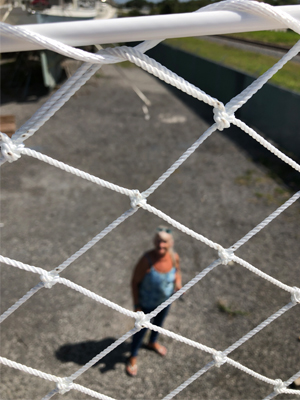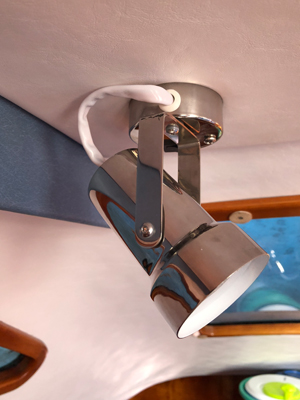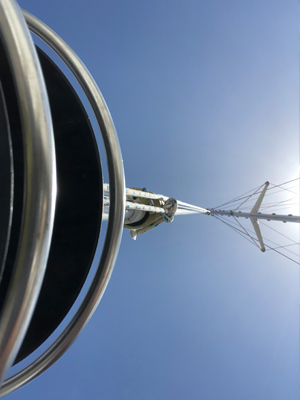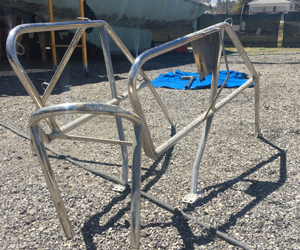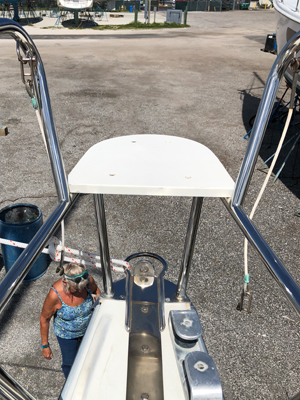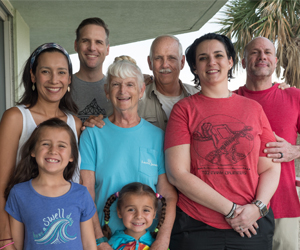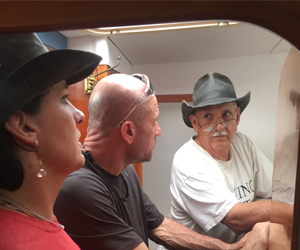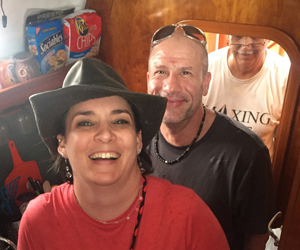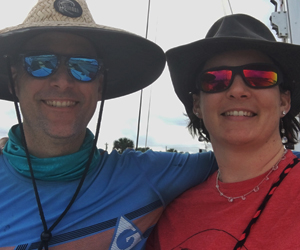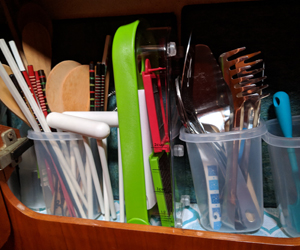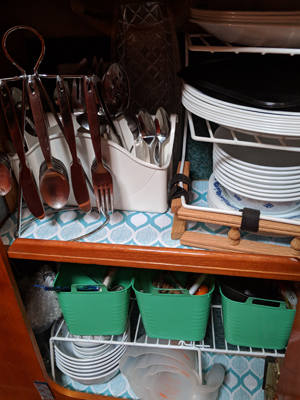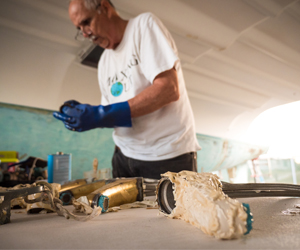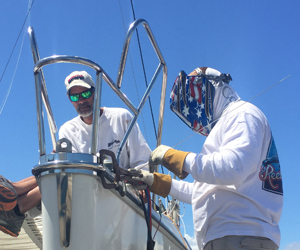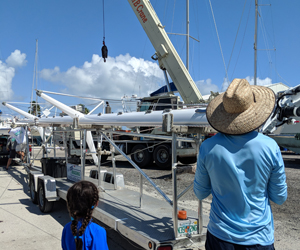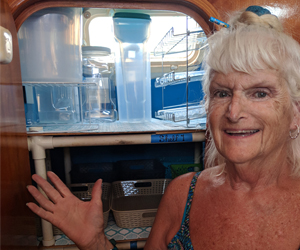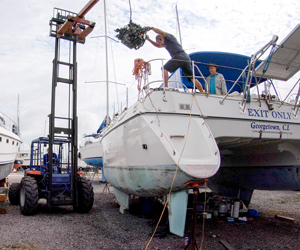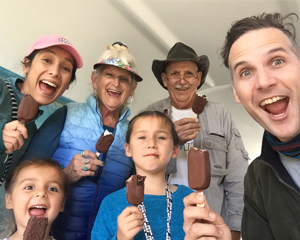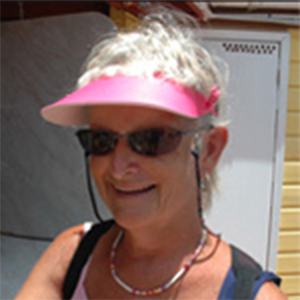We were all excited this morning! Our daughter, Wendy, and her husband, William, left Virginia to come visit us in Ft. Pierce. They were seeking a long weekend out of the cold, wet weather at home and they wanted to spend time with family and personally see the results of the hard work that was done on EXIT ONLY. Wendy was part of the crew on our first circumnavigation from Florida to New Zealand from 1994-1996. She was eager to be aboard the boat again, even if it was in the boat yard.
They actually arrived in Ft. Pierce at 0300 EST this morning after driving straight through. They got a hotel room near I-95 and were asleep shortly after unloading their gear from the rental car. Wendy called from the room around 0900 to tell us where they were and that they would see us around 1000. 1000 arrived and nothing happened. A few minutes later, Wendy called and said they were at the hotel waiting for the police...their rental car had been stolen sometime in the early morning hours!
Sarah, the girls, and I drove to the hotel. We spent the next few hours waiting for Wendy and William to talk on the phone with the police, the hotel manager (who was not on site for the weekend), the insurance company, the rental car company, the bank, etc. Because it is the weekend, it is sometimes difficult to talk to anyone who can really do something before Monday, 9 April.
When they had done all they could do about the situation for today, we had lunch out, then drove to the boat yard. The rest of the day passed in a blur of being at the boat, catching up on this and that, a lasagne supper at the condo, and tired people deciding to wind down the day a little earlier than usual. We are all glad Wendy and William arrived safely, and we are hoping tomorrow will be a better day for them! PS...I am including a picture of Wendy and William, then, a picture of our two kids...Wendy and David (Dito).
Today was a warm sunny Florida day. But as enticing as the idea of going to the beach was, all 6 of us were at Exit Only working! Dave was under the bridge deck working on through-hulls. Dito was putting the finishing touches on the cabin liner around edges and trim. Sarah was working on organizing cabin storage in the forward and aft cabins. The youngest members of the crew had the afternoon off and watched IPad (Zoe and Joss).
I was inside the boat in the galley still trying to maximize the storage space. I lined up the possible plastic pieces that I had available. I tried various combinations of different shapes and sizes in every conceivable combination. I must sound like I am obsessing over using the space to the max, and maybe I am. I get a lot of satisfaction searching for and finding a storage plan that is practical and uses the available storage space well. Obviously, space is limited, so using wire shelving, plastic containers, and plastic bins is one way to divide the storage areas. Doing this forces me to determine what goes where...is it something we will use almost everyday or is it something we will use much less than that? Is there already some of the item stored in a convenient place and we are stowing more for that day in the future when we will want them available...even if it means digging them out from what I call "deep storage"? For instance, I do not believe there is such a thing as having "too many" ziplock bags on board! Fortunately, they pack away in the smallest of places!
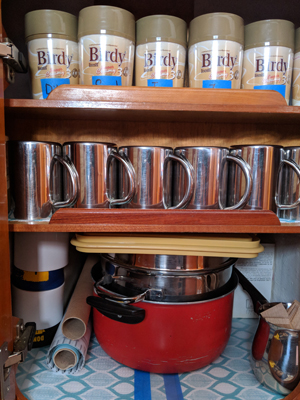
Once the bins and shelves are in place, they will be filled with the things we want to have on board. There will be a time of shifting a few things around, then finally we will declare everything stowed as well as we can get it. That is when the “all important” Master Notebook comes out and we inventory every shelf, every locker, every bin, and every nook and cranny that has something in it. I draw maps of different areas of the boat and label every storage area. Each storage area has its own page in the notebook and we list everything stored in that area on that page. We might be able to remember where we personally put things, but everyone else on board needs to be able to find those things, too! Making these lists can be tedious now, but it all pays off when we want to find something and the Notebook tells us where it is!
Thought I would be doing more organizing and planning in the galley yesterday and today, but that did not happen! This is good news though! We cannot work in the galley because of all the other good things that are happening. Dave and Dito turned their attention to the plumbing system on the boat a few days ago. They removed and replaced all 11 bronze through-hulls. That was a really time consuming job, but it is done now. It is always a sobering moment when you ponder the idea that your boat has 11 through-hulls and most of them are below the waterline.
Next, they removed the 5 faucets in the boat. All of them were "frozen” and it looked like we were going to have to replace all of them, too. They spent time looking for replacements online as well as in local stores where such things are sold. Our boat is a Privilege 39 and was built in France. Of course, many of the fittings on the boat are French. USA boat gear does not often match well. Dave and Dito finally found a replacement that would work on EXIT ONLY... in England! We all wondered how long THAT would take. Dave started taking one of the faucets apart piece by piece, cleaning it carefully, then he began to reassemble the pieces. He was able to rebuild all of the faucets and we will not have to order new ones from anywhere. We are all very happy about that.
The other good thing that happened today was the stainless steel welders showed up to do the preliminary work on our port bow pulpit (the stainless steel tubing where the lifelines are connected at the bows). In 2006, on a blustery day in the harbor at Bequia, a mega yacht hit our port bow pulpit and bent it badly. We are hoping the shiny new bow pulpit will be installed soon.
Several people have asked me if preparing the boat for blue water cruising is different this time around. We are just starting to work in the galley...measuring the same spaces again, putting down new shelf liner, going to stores with a Housewares Department, looking at baking pans, food preparation tools, utensils, containers, storage solutions, etc. When Dave and Dito cleaned the galley area, they went through everything there. As you might expect, everything in the galley that was made of stainless steel needed a wash and it was ready to use again. Lesson learned right there! Anything made of fabric had mildewed. Anything made of plastic had become brittle and shattered easily when handled. Anything made of metal that was not stainless steel, rusted.
I was surprised how many common pieces of galley gear are made out of silicone now. Obviously, the ability to push the softer pieces of gear into irregularly shaped storage areas in the galley is very appealing. The ease of cleaning is another plus. These utensils can be used with high heat. Some of the pieces are collapsible, so they take up less storage space. The fact that you can find them in many bright cheery colors is appealing, too!
Because Sarah and I both like to cook, we will do our best to have the gear we like to use with us.
Last Friday, 24 March, we were very excited because we thought our mast was going to be brought to the boat yard that day. Long story short, the mast did not make the trip from Stuart, Florida, to Ft. Pierce that day. We were told the crane to lift the mast was not available and they could not find all the pieces to our roller furler that is part of the forestay (the piece of wire rigging that goes from the top of the mast to the bow and supports the mast). The roller furler makes it possible to store the foresail wrapped (furled) around the forestay. OOOKKK...now, what did that mean for us and our boat?
Monday morning, Dave got a call from the people who had our mast. They had determined that the bottom piece of our 1995 roller furler had been stolen! They said the crane was going to be at EXIT ONLY at 2:30 that afternoon. The mast would also be arriving at that time. The mast would be lifted into place and and 4 stays would be placed fore and aft, port and starboard to support it. The new roller furler would be installed later when they had all the pieces they needed.
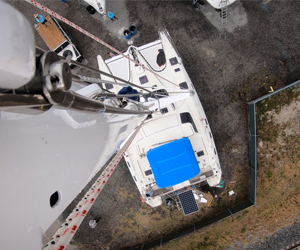
The crane and the mast both arrived as promised in the afternoon...along with dark gray storm clouds that brought higher wind and the rain. Returning a mast that is 52 feet high and weighs 1,000 pounds to the deck of your sailboat always has some hint of drama and there is great relief when it is done. Everyone decided to get out of the wind and rain and wait 15-20 minutes to see if the rain stopped. It did stop! The crane went into action and in a few minutes the mast was back in its place! EXIT ONLY is looking a lot more like herself!
Now that the cabin liner is completed, the time for going into the galley and preparing it for cruising is at hand. When Dave and Dito cleaned things out of the boat in preparation for doing the interior jobs on their list, they got rid of rusty baking pans, plastic items that were disintegrating or broken, and cloth towels that had mildewed. None of this was a surprise, because most of the galley items were purchased in 1995. We used them on our previous trip, and then left them on board when we moved off the boat in 2007.
Sarah and I have been driving north and south of Ft. Pierce on Highway #1 going to many stores looking to replace and update the galley gear. The stainless steel gear we already have needed a good cleaning, but it is all-useable. It is amazing to me how many new plastic items are available. I am fascinated by all of the silicone items, especially the collapsible ones. So far I have bought a collapsible laundry basket, a collapsible colander, a collapsible dish drainer, a collapsible salad spinner, collapsible bowls, collapsible measuring cups, collapsible funnels, etc.
We have also been seriously looking at plastic drawer dividers and holders. Again, there are so many sizes and styles of these items that it is boggles my mind!
When I did this kind of shopping in 1995 for our first big trip I had no idea what would really work on a bouncing boat in ocean waves, or what types of dividers and holders were available “out there” (whatever that meant!) if we needed more. Remembering my fear of not preparing all the galley gear to stay in place well enough makes me smile today. We are doing our best to stow everything this time and if something moves or rattles, we will find a way to fix it! There is always another way!
Today is a really big day! On the refit timeline, maybe this will be the beginning of the time we can actually watch some of the big pieces of the refit puzzle start coming together. The two new engines and the fork lift to move them from the truck to the boat are scheduled to arrive at 1000! Dave and Dito spent all day yesterday preparing the engines rooms (it is hard to call those small spaces "rooms"!).
Once the engines are in, maybe the mast will come next.. Once the mast and rigging are up, the two new genoas will be mounted on the roller fuller. Also the two wind generators can be mounted on the stern. The repaired bow pulpit can be installed on the bow, then the lifelines and safety netting can be added. There are a lot of smaller jobs to be done to make this all happen, but in our minds we can see it happening.
I wrote the first two paragraphs between 0700 and 0800 this morning. Now, I am going to tell you the rest of the story...the forklift and the two engines did arrive on time at the boatyard today. Both engines were put into their respective engine rooms and there was great joy until they tried to change the prop shafts. They shafts were damaged and not usable. What now? The shafts were taken to a machinist in Stuart, FL, so new ones could be created. Now we are waiting on the new shafts to be done so the props can be put on.
So, this was a happy day and a discouraging day all rolled into one. There have been other times when things did not happen like we expected, but the refit does continue, and the boat is looking better each day. The new cabin liner throughout the boat is beautiful. The new solar panel is mounted. The mast is supposed to come back next week, so that will make her look like a sailboat again!
We can hardly believe it, but today is the 100th day David and Dito have been working on the refit of sv/EXIT ONLY! When the work began in November 2017, none of us could have imagined we would still be in Ft. Pierce in March! We should have known better once they saw how much work there was to do and they started making a list of the jobs they wanted to see done. Some of the jobs they decided to do themselves, some they hired local people to do, and some had to be done further afield. As we "spent” time and money on the many projects, the boat that had already carried us on many adventures slowly began to return to her former seaworthy condition. Big things are happening!
Lots of boat jobs seem to be coming together. The new trampolines made by Dave and Dito are in place. Last week the new solar panel was installed and we picked up our two new sails in Ft Lauderdale. This coming week, Dave and Dito will complete redoing the whole boat interior with cabin liner. They have designed, cut, sewed, and glued over 100 yards of foam backed material to the interior of the boat. The 2 new Yanmar Diesel engines (28 horsepower each) have arrived in Stuart, Florida, from the Netherlands, and will be installed soon. Another business in Stuart has our 52’ mast. The aluminum mast was painted and the paint has been curing for weeks. That will be brought back soon on a special narrow trailer that carries long masts. A special marine welder in Stuart is working on several pieces of stainless steel pieces that mount on the bow of the boat. Another stainless steel welder is building a new bow pulpit to replace the one that was bent by a mega yacht hitting us in Bequia in 2006. on our last big trip. Once these major jobs are done, the wind generators will be remounted, new lifelines with safety netting will be installed, etc., etc., etc.
What has the rest of Team Abbott been doing? Our biggest job has been setting up home schooling for Zoe, 6, Grade 1 and Joss, 3, Pre-School. We started making lesson plans and dived right in early in January. We have one-on-one instruction for each child from 0830 to 1030 Monday-Friday. We have made changes and adjustments over the weeks, but we have come up with programs using materials that will keep the girls continuing to progress. We have done some shopping for things we know we will need, but at this point, most items are still on an Amazon Wish List. Once the interior improvements are done, we will get down to the business of getting the boat ready to be a full-time home. More about that as the time to prepare and provision arrives.
We are all working very hard and find ourselves very tired at the end of each day. This refit has taken much longer and cost more than we had imagined. On the other hand, every job has been done well and the improvements give us the motivation to keep on going and doing more. We really believe the end result will be worth it all...we will have a seaworthy boat in excellent condition for our most excellent adventure. Three generations going to sea together should be an interesting premise for making many lasting memories!.
Before we left Florida to embark on our circumnavigation in 1994, I talked to everyone I met who had cruising experience at length and asked a myriad of questions, I read books and articles about what it was like to cruise. We had done a lot of sailing, but were not blue water cruisers. We are grateful to those people who took the time to share their experiences with us and encourage us then. Now I would like to join their ranks and be a source of information and one of the "encouragers" to everyone who is contemplating going cruising.
To those of you who are making plans to go cruising on your own boat, I want to assure you that I was afraid of everything you are afraid of today and worried about everything you are worried about today. I could list 50 things that I was afraid of, but will limit myself to the top 10 things I was afaid of and tell you what really happened. Here is my list in no particular order.
#1) I was afraid ... I would forget to buy and stock something important, then we would find ourselves at sea without something we needed.
What did we do? I made lists and more lists, categorizing all the thingsI could, think of that a family of four would be using in the next few months. Every nook and cranny aboard Exit Only was filled with something I was sure we would need and I wasn't sure that we could buy "out there".
What really happened? There are people living almost everywhere you go when you are cruising. Those people eat and use the basic necessities of life everyday. We found that food was available everywhere. We found daily basics everywhere. Now it may not be the kind of food you are used to eating or choose to eat, but food is available.
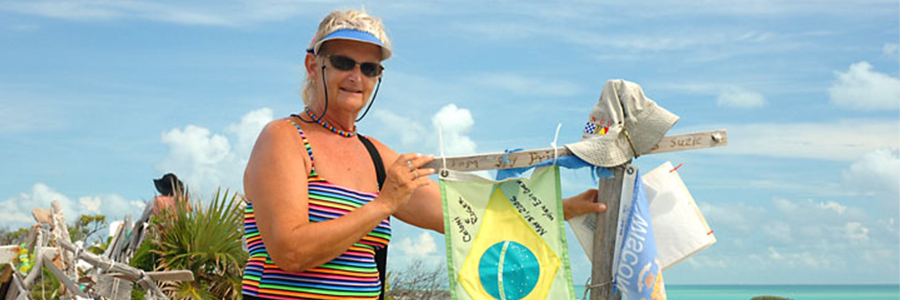
RECOMMENDATIONS: Make your lists and stock your boat with items and food you will use. If there is a particular shampoo or food you feel is important in your life, be sure and take a good supply with you. For instance, we always carried several jars of peanut butter because we all like it and never wanted to be without it. I prefer one brand of moisturizer, so I stocked up in Florida because I wanted to be sure I would have enough to use it daily. Otherwise, you will be able to buy supplies along the way. I subscribed to the “when you see something you use often on your boat, buy it” approach and it worked for us. For more information check out “The Anytime, Anywhere Provisioning List ala EXIT ONLY”.
#2) I WAS AFRAID…someone was going to steal everything from our boat.
WHAT DID WE DO? We kept loose things picked up and put away. We went snorkeling, rinsed the gear, dried it in the sun while someone was on board the boat, then put the gear away out of sight before leaving the boat. We closed and locked all of the hatches and doors when we all went off the boat. We ran a long metal cable in our dinghy to the gas container and engine, then locked our dinghy to the dock when we went ashore. We pulled our dinghy up onto the davits every night when we were at anchor.
WHAT REALLY HAPPENED? Nothing was ever stolen from our boat or dinghy. One morning we did find muddy footprints on our stern in the lagoon at St. George’s, Grenada. Someone came aboard in the night, but our dinghy was tied up on the davits securely and the doors to the inside of the boat were locked. Nothing was lying loose in the cockpit or on deck. Nothing was taken. Later that morning, we learned someone had recently been boarding boats in the night, entering through open doors or companionways, and stealing whatever was easy to grab without waking up the crew. They were taking things that were lying about like money, wallets, jewelry, cameras, computers, etc.
RECOMMENDATIONS: Lock your boat. Lock your boat when no one is aboard. Lock your boat when the crew is asleep at night. Keep all loose gear put away out of sight. If you must leave your companionway open for ventilation at night, design and construct an alarm using bells, empty tin cans, or anything that will make noise if it is disturbed. One boat we saw put screen cloth with bells attached to the edges of the cloth over their companionway at night. Moving that screen cloth without making noise was impossible.
#3) I WAS AFRAID…boat boys would surround the boat everywhere we went and effectively, “put us under siege”.
WHAT DID WE DO? I worried about how we were going to deal with boat boys, because I “just knew” there were going to be lots of them everywhere we were going. Aggressive boat boys were often included in stories about anchorages cruisers did not want to return to. We talked about what we could do when we were surrounded by boat boys. I wondered if we should carry t-shirts, cigarettes (we are not smokers), etc. to bribe them to leave us alone. The rest of the crew said “No” to carrying items for bribing them.
WHAT REALLY HAPPENED? We were not bothered by aggressive boat boys and we were certainly never surrounded by them. We did have people (men, boys, women, and girls) paddle out to our boat in many anchorages. Almost always they had something to sell…fruits and vegetables, fresh bread, lobster or fish, t-shirts or sarongs, etc. Some men came by asking if we wanted to have any boat work done or if we wanted to take a tour of the island. We would either decide to deal with them and buy something or say “No, thank you” and that would be the end of it. We asked these people not to let their boats rub against our hulls and they were careful. We did not invite them aboard. Our encounters with boat boys were good experiences.
RECOMMENDATIONS: Be friendly, but business-like when these people approach your boat. If you want to buy what they are selling, you can conduct the business with them in their boat and you in your boat. Do not feel pressured to buy what they are selling, to give them things, or to have them come aboard. We found saying “No, thank you” or “Thanks, but we are well supplied for today” with a smile was the best way to talk to the boat boys. As usual, it wasn’t so much what we said, but how we said it.
#4) I WAS AFRAID…opportunities to buy food supplies would be few and far between.
WHAT DID WE DO? Before we left Florida, I started keeping track of what we ate and what ingredients I used to prepare meals for one month. I kept my grocery receipts for that month to show me what I was buying and using. From these two lists, I started making my provisioning lists. I designed my own shopping list by dividing grocery items into 16 general categories that include most items found in a large grocery store. For more information about the EXIT ONLY shopping list and how I used it, please see the separate article entitled “The Anytime, Anywhere Provisioning List ala EXIT ONLY”.
WHAT REALLY HAPPENED? There was food for sale everywhere we went. Some of our best adventures were going to local markets or shopping in grocery stores where we did not speak the language. In Turkey, we discovered that paper towels were sold folded flat in plastic bags and potato chips were outside on the sidewalk on a stand next to the pop machine instead of on a shelf inside the store.
RECOMMENDATIONS: Long before you are ready to start cruising, start keeping track of what groceries (food and household items) you buy. Collect your grocery lists and grocery receipts for at least one month. Buy a ring binder with loose pages you can add or remove. Make lists of the items on your grocery lists and receipts and organize the lists in a way that makes sense to you. If you would like to see my master shopping list, look at my article entitled “The Anytime, Anywhere Shopping List ala EXIT ONLY”. Only provision with foods your crew will eat. If they do not like a particular food on shore, they will not like it at sea either. For example, I stored three kinds of lentils aboard because they are easy to store, keep well, and are loaded with protein. I love lentils, but no one else in the crew liked them. I ended up trading them away for peanut butter in the Marquesas Islands!
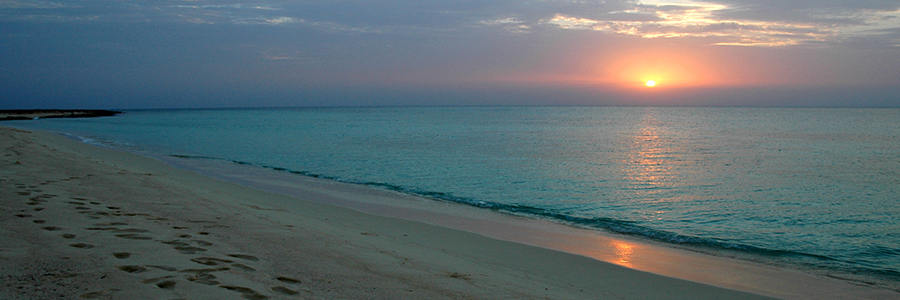
#5) I WAS AFRAID…I would be sea-sick during all of the passages.
WHAT DID WE DO? I do/did get seasick at the beginning of every passage. I have tried several “cures” for seasickness including Sturgeron Forte, the Scopolamine patch, Pahia Bombs from Pahia, New Zealand, the “watch” with electrical pulses, etc.
WHAT REALLY HAPPENED? Three out of four of our crew members had some sea-sickness at the beginning of every passage. Two found some relief using Sturgeron Forte. I used half of a patch behind my ear and felt some relief. I also wore a “watch” and it seemed to help. However bad the sea-sickness, everyone was better by day three and cured by day four every time. Knowing that day three was coming helped on days one and two. We also noted that reading on days one and two seemed to make the sea-sickness worse. Before we left on a passage, I would prepare food that could easily be eaten by anyone who wanted to eat during the first three days of the passage. I was not able to cook for the first three days, but by day four, hot food sounded good to everyone. Potato soup became a welcome tradition on day four. Potato soup for lunch meant that once again, we had survived the first three days of being seasick!
RECOMMENDATIONS: If you suffer from seasickness, you belong to a very large club. Seasickness and its cures are always a hot topic when cruisers gather together. Try to discover what medication or cure works best for each person in your crew and stock up on these items. Prepare some food before you leave on a passage, so no one needs to cook for the first few days. Have bland foods like crackers available. Drinking ginger tea or sucking on ginger candies often helps settle your stomach. Do not read or write until you are feeling 100%.
#6) I WAS AFRAID…I would be scared on night watch when it was pitch black dark.
WHAT DID WE DO? Some of our crew members liked being up in the middle of the night more than others did. I preferred the early evening or early morning watch, but all of us had to take our turn in the middle of the night. At first, I dreaded being on watch by myself in the middle of the night, but as my confidence grew, I became more comfortable with the idea. I came to appreciate the moon and stars in a new way.
WHAT REALLY HAPPENED? We always had someone on watch and we used a flexible watch schedule. You had to take at least three hours of watch, then could take more watch if you felt like it. If the person on watch thought there was a big change in the wind or weather, that person would wake another crew member up and assess what needed to be done. Dave was always available if the person on watch thought he should be awakened and told about something that was happening (wind was up, ships lights near-by, etc.) Surprisingly, all of us came to appreciate night watch. Seeing the moon rising over the water, a full moon shining down on the waves, constellations moving across the sky, and the stars in the Milky Way lighting our path all became special memories. Seeing the phosphorescence in the water moving as it outlined fish swimming along with us was amazing. The phosphorescent glow on our stern waves reflected our path through the water. The sea at night has its own unique beauty.
RECOMMENDATIONS: We bought night-vision binoculars before we left Florida. We kept those binoculars handy on night watch. On a pitch black night, the smallest light in the distance on a ship or fishing boat was magnified by the binoculars. We could easily see the port and starboard lights of other vessels at a greater distance using the binoculars. This gave us more time to make any adjustments we needed to our course.
#7) I WAS AFRAID…we wouldn’t be able to keep in touch with friends and family.
WHAT DID WE DO? When we left Florida in 1995, we did not have e-mail, Sailmail, Airmail, Skype, etc. We got a booklet that listed all of the American Express offices in the world and arranged to have our mail drops at these offices. We would use public phones to notify our family that we had arrived at a destination immediately after checking in with officials.
WHAT REALLY HAPPENED? We evolved with the cyber world. As soon as e-mail became available, we installed the equipment we needed to access Sailmail, Airmail, and Skype. Whether we were at anchor or at sea, we found ourselves communicating daily with family and friends and literally sharing our adventure with them almost as it happened. We would e-mail our latitude and longitude to our kids and parents when we were on passage. They enjoyed following our progress on globes at their houses in Kentucky and Florida.
RECOMMENDATIONS: Buy the equipment needed to access Sailmail, Airmail (if you have a ham radio license), and Skype. Cruisers everywhere are using these services and will be happy to share their expertise and experiences with you.
#8) I WAS AFRAID…our children’s education would suffer.
WHAT DID WE DO? When we left on our circumnavigation, Wendy was 16 and had two years of high school left to complete. David was 15 and had three years of high school left to complete. We registered with the University of Nebraska High School Correspondence School in Lincoln, Nebraska. The school sent each student a syllabus of each course with all the materials needed to complete the work. The lesson directions were written to the student. Our kids only needed help from us for Junior-level English (complex grammar, I helped) and Chemistry (Dave helped). Remember, this was before e-mail, so we depended on the postal systems around the world to send and return their assignments. Today, the class work is sent both ways by e-mail. We left with a full semester of class supplies. We purchased the next semester’s materials and had them sent to American Samoa using the U.S. Postal System.
WHAT REALLY HAPPENED? Both of our kids did very well with their course work. I am a teacher and it was obvious to me the lessons were well-written and the directions were straight-forward and easy to follow. The hardest part of the schooling was having the self-discipline needed to stick to doing school work when the adventure of being in a new and different location was waiting a dinghy ride away.
RECOMMENDATIONS: Do your research before you leave and find the correspondence school that suits your child’s needs. We were very pleased with the school we chose. On board EXIT ONLY, we planned “school time” in the mornings until noon. We all stayed on the boat in the mornings. Dave and I did boat work while the kids did school work. After lunch, we would all “play”. We found this schedule was a good balance between school/boat work and adventure.
#9)I WAS AFRAID…I wasn’t a good enough sailor when it came to running the electronics, plotting on charts, reading the sea, wind, clouds, etc.
WHAT DID WE DO? When we left Florida, Dave was an extremely competent and knowledgeable captain. The kids and I were good crew who did everything we were told to do. We had the big picture, but didn’t know much about the details. As a family, we attended a Safety at Sea Seminar in Ft. Lauderdale before we left. The main impact of that seminar was the realization that we all needed to know the basics of running the boat, what to do in an emergency, and how to start and stop the boat. We did not know all of these things when we left, but we immediately started learning and practicing them as we headed west from Florida.
WHAT REALLY HAPPENED? Everyday, we all were involved in all of the aspects of making the boat move. Dave explained how to use the electronic equipment and each of us slowly, but surely, became proficient at using the electronics, plotting our course, reading charts, reading the sea, reading the wind, and reading the clouds. At first, Dave would tell us where we were going and we all agreed. As our skills grew, we wanted to be more involved in the process of deciding what our destination would be and wanted to discuss options.
RECOMMENDATIONS: Everyone on the boat should have basic sailing skills. Everyone should know how to start and stop the boat. Everyone should know how to use the radio. There are sailing classes for every level of ability, so finding one that suits you should be easy. Successfully completing a sailing class goes a long way toward instilling self-confidence. Get as much offshore experience as you can before you head out on your own. I would also recommend that the whole crew attends a Safety At Sea Seminar.
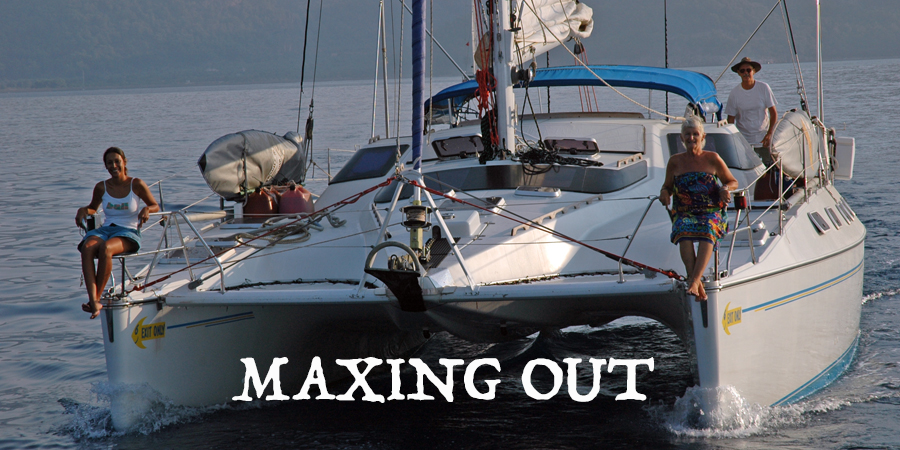
#10) I WAS AFRAID …that everyone knew more than me and I would never be a “real” sailor.
WHAT DID WE DO? I participated in every aspect of preparing the boat to leave. I asked questions about everything. I made notes about things I wanted to remember. We attended a Safety at Sea Seminar as a family. We made every effort to include safety equipment aboard. I read seamanship books and talked to experienced cruisers.
WHAT REALLY HAPPENED? As we sailed off on our adventure, each crew member made an effort to participate in all phases of the journey. We all learned skills that were needed to keep the boat moving efficiently. On passages, our watches would keep us busy. We kept a ship’s log of every passage. We made an entry in the log on the hour that included local time, compass heading, average speed, distance log, helmsman, sky, wind, barometric pressure, latitude, longitude, and pertinent comments. Having to fill in the log made us aware of what was really happening with the boat and our environment.
RECOMMENDATIONS: Take an active roll in keeping the boat moving. Take an active interest is what is going on both on the boat and outside the boat. If learning aboard is difficult, consider taking a sailing course on a boat that is similar to yours. You will enjoy your time on your boat if you are an active part of the crew and if you feel confident that you have the basic skills to control the boat in an emergency.
So, if you are thinking that you are the only one who is afraid to go to sea, now you know you are not alone. Hopefully, sharing my fears and how I dealt with them has helped you face your own fears. Start making plans to do things that will help you become a confident, competent crew member. Don’t let fear rob you of your dreams!


